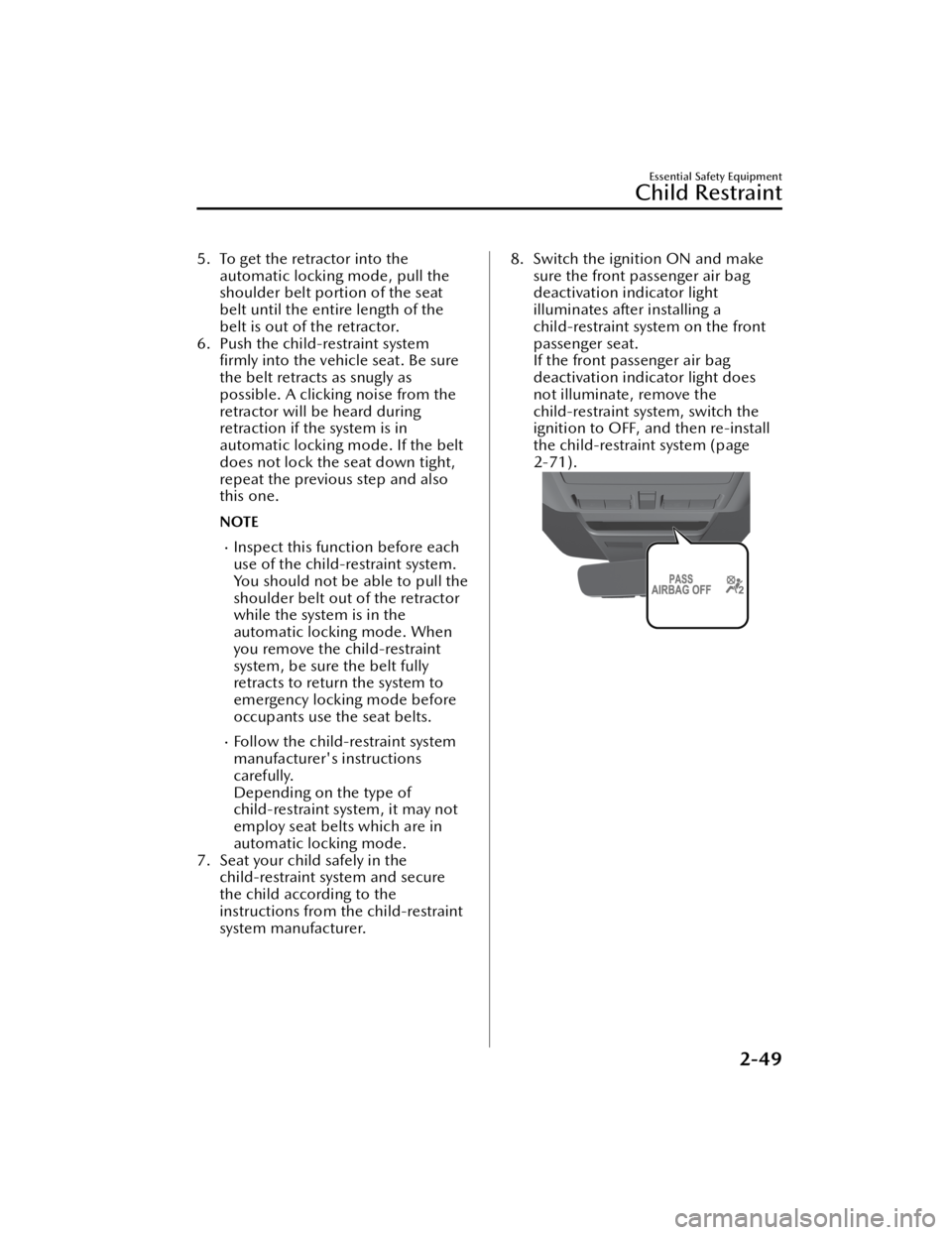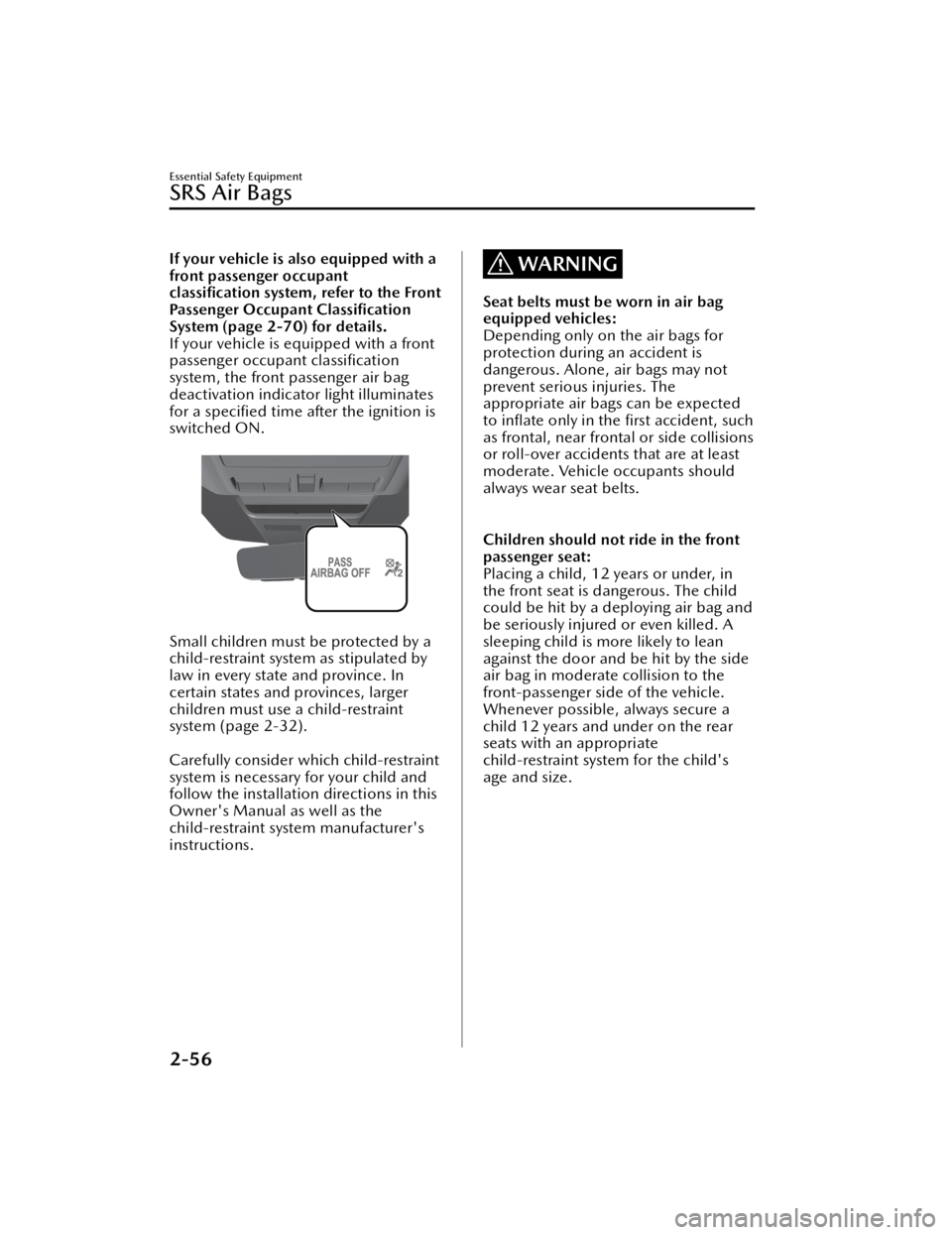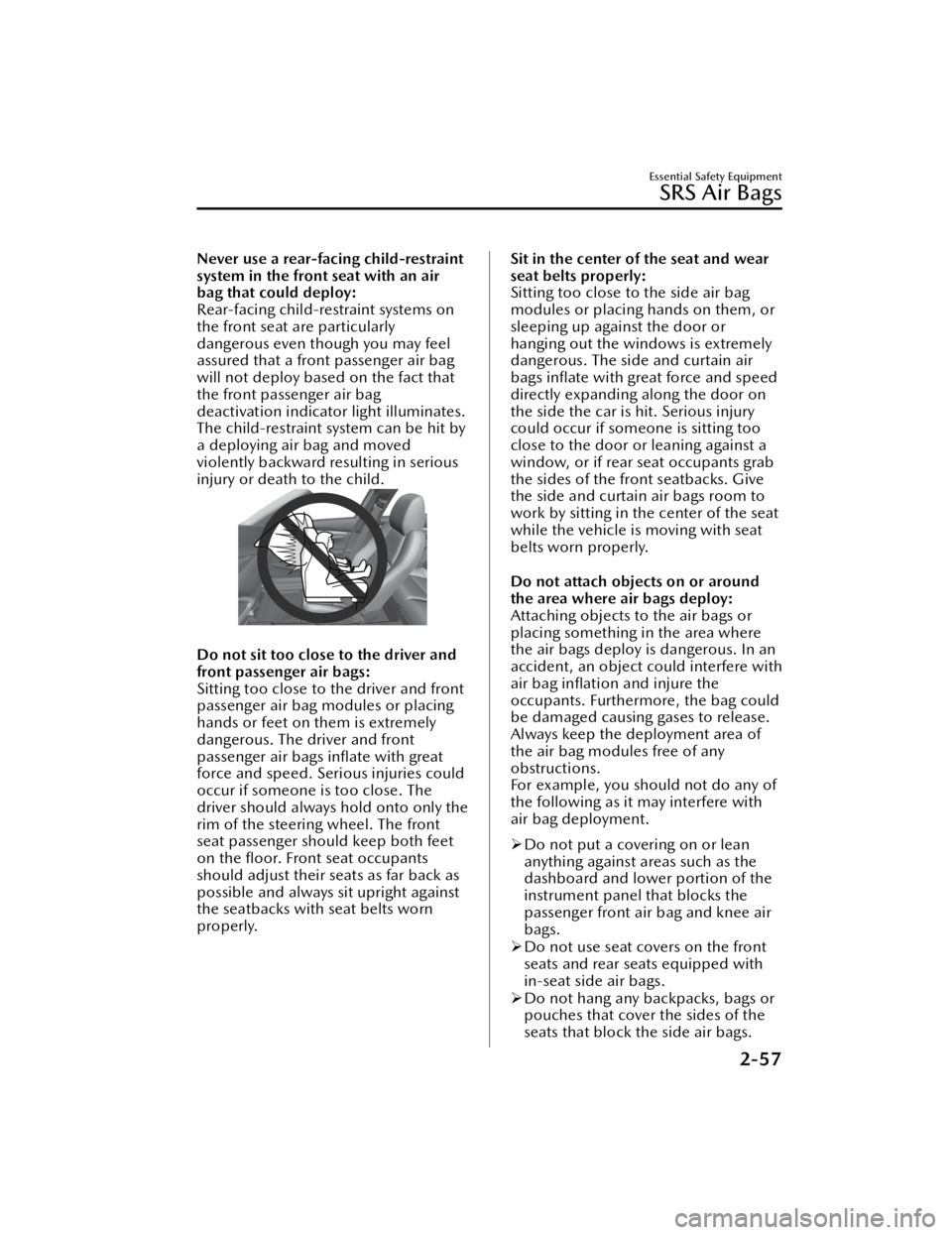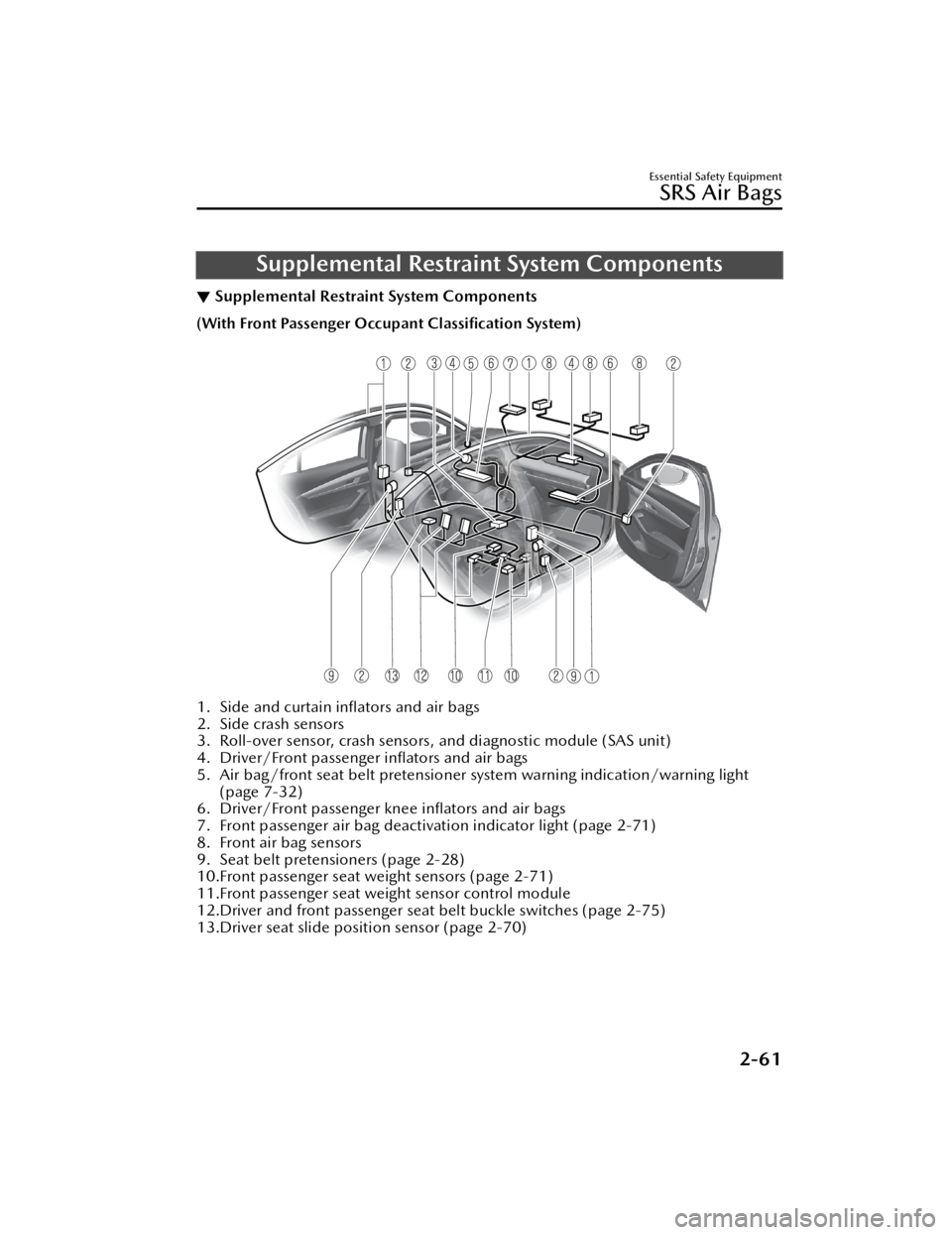light MAZDA MODEL 3 HATCHBACK 2021 Owner's Manual
[x] Cancel search | Manufacturer: MAZDA, Model Year: 2021, Model line: MODEL 3 HATCHBACK, Model: MAZDA MODEL 3 HATCHBACK 2021Pages: 612, PDF Size: 89.06 MB
Page 63 of 612

5. To get the retractor into theautomatic locking mode, pull the
shoulder belt portion of the seat
belt until the entire length of the
belt is out of the retractor.
6. Push the child-restraint system firmly into the vehicle seat. Be sure
the belt retracts as snugly as
possible. A clicking noise from the
retractor will be heard during
retraction if the system is in
automatic locking mode. If the belt
does not lock the seat down tight,
repeat the previous step and also
this one.
NOTE
Inspect this function before each
use of the child-restraint system.
You should not be able to pull the
shoulder belt out of the retractor
while the system is in the
automatic locking mode. When
you remove the child-restraint
system, be sure the belt fully
retracts to return the system to
emergency locking mode before
occupants use the seat belts.
Follow the child-restraint system
manufacturer's instructions
carefully.
Depending on the type of
child-restraint system, it may not
employ seat belts which are in
automatic locking mode.
7. Seat your child safely in the child-restraint system and secure
the child according to the
instructions from the child-restraint
system manufacturer.
8. Switch the ignition ON and makesure the front passenger air bag
deactivation indicator light
illuminates after installing a
child-restraint system on the front
passenger seat.
If the front passenger air bag
deactivation indicator light does
not illuminate, remove the
child-restraint system, switch the
ignition to OFF, and then re-install
the child-restraint system (page
2-71).
Essential Safety Equipment
Child Restraint
2-49
Mazda3_8JM2-EA -20H_Edition1_new 2020-7-10 17:21:34
Page 64 of 612

WARNING
Do not seat a child in a child-restraint
system on the front passenger seat if
the front passenger air bag
deactivation indicator light does not
illuminate:
While it is always better to install any
child-restraint system on the rear seat,
it is imperative that a child-restraint
system ONLY be used on the front
passenger seat if the deactivation
indicator light illuminates when the
child is seated in the child-restraint
system (page 2-71). Seating a child in
a child-restraint system installed on the
front passenger seat with the front
passenger air bag deactivation
indicator light not illuminated is
dangerous. If this indicator light does
not illuminate, this means that the
front passenger front and side air bags,
and knee air bags, and seat belt
pretensioners are ready for
deployment. If an accident were to
deploy an air bag, a child in a
child-restraint system sitting in the
front passenger seat could be seriously
injured or killed. If the indicator light
does not illuminate after seating a
child in a child-restraint system on the
front passenger seat, seat a child in a
child-restraint system on the rear seat
and consult an Authorized Mazda
Dealer as soon as possible.
▼ Using ISOFIX Lower Anchor
(Mexico)/Using LATCH Lower
Anchor (Except Mexico)
Your Mazda is equipped with ISOFIX/
LATCH*1 lower anchors for attachment
of specially designed ISOFIX/LATCH*1
child-restraint systems in the rear seats.
Both anchors must be used, otherwise
the seat will bounce around and put
the child in danger. Most ISOFIX/
LATCH
*1 child-restraint systems must
also be used in conjunction with a
tether to be e ffective. If they have a
tether you must use it to better assure
your child's safety.
WARNING
Follow the manufacturer's
instructions for the use of the
child-restraint system:
An unsecured child-restraint system is
dangerous. In a sudden stop or a
collision it could move causing serious
injury or death to the child or other
occupants. Make sure the
child-restraint system is properly
secured in place according to the
child-restraint system manufacturer's
instructions.
Essential Safety Equipment
Child Restraint
2-50
Mazda3_8JM2-EA -20H_Edition1_new 2020-7-10 17:21:34
Page 70 of 612

If your vehicle is also equipped with a
front passenger occupant
classification system, refer to the Front
Passenger Occupant Classi fication
System (page 2-70) for details.
If your vehicle is equipped with a front
passenger occupant classi fication
system, the front passenger air bag
deactivation indicator light illuminates
for a speci fied time after the ignition is
switched ON.
Small children must be protected by a
child-restraint system as stipulated by
law in every state and province. In
certain states and provinces, larger
children must use a child-restraint
system (page 2-32).
Carefully consider which child-restraint
system is necessary for your child and
follow the installation directions in this
Owner's Manual as well as the
child-restraint system manufacturer's
instructions.
WARNING
Seat belts must be worn in air bag
equipped vehicles:
Depending only on the air bags for
protection during an accident is
dangerous. Alone, air bags may not
prevent serious injuries. The
appropriate air bags can be expected
to in flate only in the first accident, such
as frontal, near frontal or side collisions
or roll-over accidents that are at least
moderate. Vehicle occupants should
always wear seat belts.
Children should not ride in the front
passenger seat:
Placing a child, 12 years or under, in
the front seat is dangerous. The child
could be hit by a deploying air bag and
be seriously injured or even killed. A
sleeping child is more likely to lean
against the door and be hit by the side
air bag in moderate collision to the
front-passenger side of the vehicle.
Whenever possible, always secure a
child 12 years and under on the rear
seats with an appropriate
child-restraint system for the child's
age and size.
Essential Safety Equipment
SRS Air Bags
2-56
Mazda3_8JM2-EA -20H_Edition1_new 2020-7-10 17:21:34
Page 71 of 612

Never use a rear-facing child-restraint
system in the front seat with an air
bag that could deploy:
Rear-facing child-restraint systems on
the front seat are particularly
dangerous even though you may feel
assured that a front passenger air bag
will not deploy based on the fact that
the front passenger air bag
deactivation indicator light illuminates.
The child-restraint system can be hit by
a deploying air bag and moved
violently backward resulting in serious
injury or death to the child.
Do not sit too close to the driver and
front passenger air bags:
Sitting too close to the driver and front
passenger air bag modules or placing
hands or feet on them is extremely
dangerous. The driver and front
passenger air bags inflate with great
force and speed. Serious injuries could
occur if someone is too close. The
driver should always hold onto only the
rim of the steering wheel. The front
seat passenger should keep both feet
on the floor. Front seat occupants
should adjust their seats as far back as
possible and always sit upright against
the seatbacks with seat belts worn
properly.
Sit in the center of the seat and wear
seat belts properly:
Sitting too close to the side air bag
modules or placing hands on them, or
sleeping up against the door or
hanging out the windows is extremely
dangerous. The side and curtain air
bags in flate with great force and speed
directly expanding along the door on
the side the car is hit. Serious injury
could occur if someone is sitting too
close to the door or leaning against a
window, or if rear seat occupants grab
the sides of the front seatbacks. Give
the side and curtain air bags room to
work by sitting in the center of the seat
while the vehicle is moving with seat
belts worn properly.
Do not attach objects on or around
the area where air bags deploy:
Attaching objects to the air bags or
placing something in the area where
the air bags deploy is dangerous. In an
accident, an object could interfere with
air bag in flation and injure the
occupants. Furthermore, the bag could
be damaged causing gases to release.
Always keep the deployment area of
the air bag modules free of any
obstructions.
For example, you should not do any of
the following as it may interfere with
air bag deployment.
Do not put a covering on or lean
anything against areas such as the
dashboard and lower portion of the
instrument panel that blocks the
passenger front air bag and knee air
bags.
Do not use seat covers on the front
seats and rear seats equipped with
in-seat side air bags.
Do not hang any backpacks, bags or
pouches that cover the sides of the
seats that block the side air bags.
Essential Safety Equipment
SRS Air Bags
2-57
Mazda3_8JM2-EA -20H_Edition1_new 2020-7-10 17:21:34
Page 74 of 612

Properly dispose of the air bag
system:
Improper disposal of an air bag or a
vehicle with live air bags in it can be
extremely dangerous. Unless all safety
procedures are followed, injury could
result. Have an Authorized Mazda
Dealer safely dispose of the air bag
system or scrap an air bag equipped
vehicle.
NOTE
If it becomes necessary to have the
components or wiring system for the
supplementary restraint systemmodi fied to accommodate a person
with certain medical conditions in
accordance with a certi fied
physician, contact an Authorized
Mazda Dealer, refer to “Customer
Assistance (U.S.A.)” (page 8-2).
When an air bag deploys, a loud in flation noise can be heard and
some smoke will be released.
Neither is likely to cause injury,
however, the texture of the air bags
may cause light skin injuries on body
parts not covered with clothing
through friction.
Should you sell your Mazda, we urge
you to tell the new owner of its air
bag systems and that familiarization
with all instructions about them,
from the Owner's Manual, is
important.
This highly-visible label is displayed
which warns against the use of a
rear-facing child-restraint system on
the front passenger seat.
(Mexico)
(Except Mexico)
Essential Safety Equipment
SRS Air Bags
2-60
Mazda3_8JM2-EA -20H_Edition1_new 2020-7-10 17:21:34
Page 75 of 612

Supplemental Restraint System Components
▼Supplemental Restraint System Components
(With Front Passenger Occupant Classifi
cation System)
1. Side and curtain inflators and air bags
2. Side crash sensors
3. Roll-over sensor, crash sensors, and diagnostic module (SAS unit)
4. Driver/Front passenger in flators and air bags
5. Air bag/front seat belt pretensioner system warning indication/warning light (page 7-32)
6. Driver/Front passenger knee in flators and air bags
7. Front passenger air bag deactivation indicator light (page 2-71)
8. Front air bag sensors
9. Seat belt pretensioners (page 2-28)
10.Front passenger seat we ight sensors (page 2-71)
11.Front passenger seat weight sensor control module
12.Driver and front passenger seat belt buckle switches (page 2-75)
13.Driver seat slide position sensor (page 2-70)
Essential Safety Equipment
SRS Air Bags
2-61
Mazda3_8JM2-EA -20H_Edition1_new 2020-7-10 17:21:34
Page 76 of 612

(Without Front Passenger Occupant Classification System)
1. Side and curtain inflators and air bags
2. Side crash sensors
3. Driver/Front passenger in flators and air bags
4. Air bag/ front seat belt pretensioner system warning indication
/warning light (page 7-32)
5. Driver knee in flator and air bag
6. Front air bag sensor
7. Seat belt pretensioners (page 2-28)
8. Crash sensors, and diagnostic module (SAS unit)
Essential Safety Equipment
SRS Air Bags
2-62
Mazda3_8JM2-EA -20H_Edition1_new 2020-7-10 17:21:34
Page 80 of 612

(With Front Passenger Occupant
Classification System)
In a roll-over:
In response to a vehicle roll-over, both
curtain air bags infl ate.
Both curtain air bags will deploy after
the roll-over accident is detected.
▼ Warning Light/Beep
A system malfunction or operation
conditions are indicated by a warning.
Refer to Air Bag/Front Seat Belt
Pretensioner System Warning
Indication/Warning Light on page
7-32.
Essential Safety Equipment
SRS Air Bags
2-66
Mazda3_8JM2-EA
-20H_Edition1_new 2020-7-10 17:21:34
Page 84 of 612

Limitations to roll-over detection
(With Front Passenger Occupant
Classification System):
The following illustration is an example
of an accident that may not be
detected as a roll-over accident.
Therefore, the front seat belt
pretensioners and curtain air bags may
not deploy.
Pitch end over end
Driver and Front
Pa s s e n g e r O cc u p a n t
Classi fication System
*
▼ Driver and Front Passenger
Occupant Classi
fication System
First, please read "Supplemental
Restraint System (SRS) Precautions"
(page 2-55) carefully.
▼ Driver Seat Slide Position Sensor
Your vehicle is equipped with a driver
seat slide position sensor as a part of
the supplemental restraint system. The
sensor is located under the driver seat.
The sensor determines whether the
driver seat is fore or aft of a reference
position and sends the seat position to
the diagnostic module (SAS unit).
The SAS unit is designed to control the
deployment of the driver air bag
depending on how close the driver
seat is to the steering wheel.
The air bag/front seat belt
pretensioner system warning light
fl
ashes if the sensor has a possible
malfunction (page 2-66).
Essential Safety Equipment
SRS Air Bags
2-70*Some models.
Mazda3_8JM2-EA -20H_Edition1_new 2020-7-10 17:21:34
Page 85 of 612

▼Front Passenger Seat Weight
Sensors
Your vehicle is equipped with a front
passenger seat weight sensors as a part
of the supplemental restraint system.
These sensors are located under both
of the front passenger seat rails. These
sensors determine the total seated
weight on the front passenger seat and
monitor the seat belt buckle for the
front passenger seat. The SAS unit is
designed to prevent the front
passenger front and side air bags and
knee air bags, and seat belt
pretensioner system from deploying if
the front passenger air bag
deactivation indicator light illuminates.
To reduce the chance of injuries
caused by deployment of the front
passenger air bag, the system
deactivates the front passenger front
and side air bags and knee air bags,
and also the seat belt pretensioner
system when the front passenger air
bag deactivation indicator light
illuminates. Refer to the following
table for the front passenger air bag
deactivation indicator light
illumination conditions.
This system shuts o
ff the front
passenger front and side air bags and
knee air bags, and seat belt
pretensioner system, so make sure the
front passenger air bag deactivation
indicator light illuminates according to
the following table.
The air bag/front seat belt
pretensioner system warning light
fl ashes and the front passenger air bag
deactivation indicator light illuminates
if the sensors have a possible
malfunction. If this happens, the front
passenger front and side air bags and
knee air bags, and seat belt
pretensioner system will not deploy.
Front passenger air bag deactivation
indicator light
This indicator light illuminates to
remind you that the front passenger
front and side air bags and knee air
bags, and seat belt pretensioners will
not deploy during a collision.
Essential Safety Equipment
SRS Air Bags
2-71
Mazda3_8JM2-EA -20H_Edition1_new 2020-7-10 17:21:34